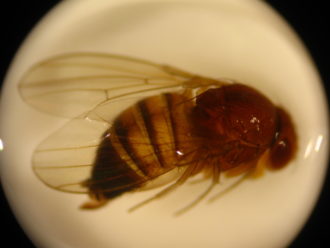GAINESVILLE, Florida – University of Florida researchers are expanding the Integrated Pest Management (IPM) toolbox for blueberry growers fighting the spotted wing Drosophila (Drosophila suzukii) – a destructive pest of small fruit crops.
Through a Southern Sustainable Agriculture Research & Education (SSARE) Graduate Student Grant (GS12-114), entomology graduate student Lindsy Iglesias, along with professor Oscar Liburd, identified additional IPM techniques that may help growers better manage the pest.
The spotted wing Drosophila – a vinegar fly related to the common fruit fly -- arrived in the United States from Asia in 2008 and has spread across the Southeast. It showed up for the first time in Florida in 2009. The females use a serrated egg-laying structure to puncture the fruit’s thin skin and lay several eggs inside the fruit. It only takes a few days for the larvae to hatch and begin feeding on the crop. Iglesias said that it’s not uncommon for several females to lay claim to one fruit, dramatically increasing the number of larvae that can attack the crop. From 2012 to 2014, Iglesias found that the highest populations of this fly are found in the central and north-central parts of the state.
“It’s generally recognized that the economic threshold of the pest is one,” said Iglesias.
Currently, some chemicals are available to control the pest, and growers are also encouraged to apply cultural control methods, such as frequent harvest intervals and crop sanitation (picking up dropped fruit to prevent additional habitat sources).
But Iglesias was interested in expanding grower options.
In the SSARE-funded project, she researched several IPM techniques:
- Trapping with different baits. Using a trap and lure system, the researchers experimented with various types of baits – apple cider vinegar, wine and yeast-based. While the apple cider vinegar works, results showed that the yeast mixtures (yeast/sugar and yeast/flour) were the most effective baits. “The yeast mixtures captured more spotted wing Drosophila and capture them sooner in the season than the other vinegar baits tested,” said Iglesias.
- Trapping with different traps. Researchers used a basic cup trap (a plastic cup and lid with holes along the upper rim), a combination of the cup and yellow stimulus cards, and a yellow sticky card to trap the pest. Results found that none of the traps had a significant effect on spotted wing Drosophila captures. “The results are consistent with previous findings that the color yellow does not increase trap captures,” said Iglesias. “In fact, this suggests that the type of bait is a more important factor in attracting the pest than trap designs.”
- Timing. “The spotted wing Drosophila prefers ripening fruit, but will lay eggs in damaged fruit if nothing else is available,” said Iglesias. “If we can identify susceptible blueberry varieties, or determine the susceptibility of the fruit’s ripening stages, it may help the grower choose cultivars that control pest populations, or implement techniques such as buffers that disrupt pest distribution.” The study indicated that spotted wing Drosophila will attack unripe berries and therefore the best time for beginning monitoring programs for this fly is when the berries begin to turn from green to pink.
In addition to cultural techniques, the researchers identified additional insecticides, which are recommended for use in a rotational program to manage the spotted wing Drosophila.
More information on the research results can be found in the study’s final report, "Developing an Integrated Pest Management Program for a Newly Introduced Pest in Florida Blueberries: The spotted wing Drosophila, Drosophila suzukii."
--30--
Published by the Southern Region of the Sustainable Agriculture Research and Education (SARE) program. Funded by the USDA National Institute of Food and Agriculture (NIFA), Southern SARE operates under cooperative agreements with the University of Georgia, Fort Valley State University, and the Kerr Center for Sustainable Agriculture to offer competitive grants to advance sustainable agriculture in America's Southern region. This material is based upon work that is supported by the National Institute of Food and Agriculture, U.S. Department of Agriculture, through Southern Sustainable Agriculture Research and Education, under sub-award number: GS12-114. USDA is an equal opportunity employer and service provider. Any opinions, findings, conclusions, or recommendations expressed in this publication are those of the author(s) and do not necessarily reflect the view of the U.S. Department of Agriculture.
